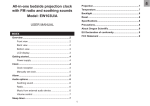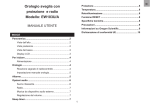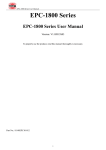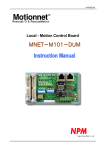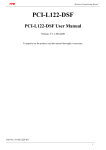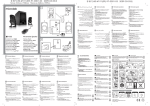Download Stepper Driver STP
Transcript
TPM Motionnet Programming Manual Stepper Driver STP-M111 User Manual Version: V1.2 2012J30 To properly use the product, read this manual thoroughly is necessary. Part No.: 81-00STP10-010 1 TPM Motionnet Programming Manual Revision History Date Revision Description 2012/9/3 1.0 Document creation. 2013/1/1 1.1 Added an illustration on system architecture. 2013/1/28 1.2 1. Update mechanical dimensions. 2. Added options of STP-M111A and STP-M111B 2 TPM Motionnet Programming Manual © Copyright 2012 TPM The product, including the product itself, the accessories, the software, the manual and the software description in it, without the permission of TPM Inc. (“TPM”), is not allowed to be reproduced, transmitted, transcribed, stored in a retrieval system, or translated into any language in any form or by any means, except the documentation kept by the purchaser for backup purposes. The names of products and corporations appearing in this manual may or may not be registered trademarks, and may or may not have copyrights of their respective companies. These names should be used only for identification or explanation, and to the owners’ benefit, should not be infringed without any intention. The product’s name and version number are both printed on the product itself. Released manual visions for each product design are represented by the digit before and after the period of the manual vision number. Manual updates are represented by the third digit in the manual vision number. Trademark MS-DOS and Windows 95/98/NT/2000/XP, Visual Studio, Visual C++, Visual BASIC are registered trademarks of Microsoft. BCB (Borland C++ Builder) is registered trademark of Borland. Other product names mentioned herein are used for identification purposes only and may be trademarks and/or registered trademarks of their respective companies. 3 TPM Motionnet Programming Manual Electrical safely To prevent electrical shock hazard, disconnect the power cable from the electrical outlet before relocating the system. When adding or removing devices to or from the system, ensure that the power cables for the devices are unplugged before the signal cables are connected. Disconnect all power cables from the existing system before you add a device. Before connecting or removing signal cables from motherboard, ensure that all power cables are unplugged. Seek professional assistance before using an adapter or extension card. These devices could interrupt the grounding circuit. Make sure that your power supply is set to the voltage available in your area. If the power supply is broken, contact a qualified service technician or your retailer. Operational safely Please carefully read all the manuals that came with the package, before installing the new device. Before use ensure all cables are correctly connected and the power cables are not damaged. If you detect and damage, contact the dealer immediately. To avoid short circuits, keep paper clips, screws, and staples away from connectors, slots, sockets and circuitry. Avoid dust, humidity, and temperature extremes. Do not place the product in any area where it may become wet. If you encounter technical problems with the product, contact a qualified service technician or the dealer. 4 TPM Motionnet Programming Manual Contents CONTENTS .................................................................................................................................................................................. 5 1. INTRODUCTION ...................................................................................................................................................................... 6 1.1. PRECAUTIONS .............................................................................................................................................................................. 6 1.1.1. Safety precautions .................................................................................................................................................. 6 1.1.2. Handling precautions ............................................................................................................................................. 6 1.2. FEATURES.................................................................................................................................................................................... 7 1.2.1. Serial Communications .......................................................................................................................................... 7 1.2.2. Motion control ....................................................................................................................................................... 8 1.2.3. Motor driver ......................................................................................................................................................... 11 1.3. SPECIFICATIONS .......................................................................................................................................................................... 12 1.3.1. Serial communications ......................................................................................................................................... 12 1.3.2. Motion Control .................................................................................................................................................... 13 1.3.3. Motor Driving Operations .................................................................................................................................... 14 1.3.4. Others ................................................................................................................................................................... 15 2. HARDWARE SPECIFICATIONS ................................................................................................................................................ 16 2.1. MECHANICAL DIMENSIONS .......................................................................................................................................................... 16 2.2. I/O INTERFACES ......................................................................................................................................................................... 17 2.2.1. Dip Switches ........................................................................................................................................................ 18 2.2.2. Motionnet Rings .................................................................................................................................................. 19 2.2.3. RS1 – Rotary Switch ............................................................................................................................................ 19 2.2.4. VR1 – Stop Power ............................................................................................................................................... 20 2.2.5. VR2 – Run Power ................................................................................................................................................ 20 2.2.6. Mechanical Input ................................................................................................................................................. 20 2.2.7. Motor Connector .................................................................................................................................................. 21 2.2.8. Power Input .......................................................................................................................................................... 21 2.2.9. Encoder Source .................................................................................................................................................... 21 2.3. WIRING DIAGRAM ...................................................................................................................................................................... 22 2.4. APPLICATION ARCHITECTURE ........................................................................................................................................................ 24 5 TPM Motionnet Programming Manual 1. Introduction STP-M111 is a 2-phase high speed Motionnet interfaced stepping motor driver. Encoder support and high precision position drive simplifies the control of motion. 1.1. Precautions 1.1.1. Safety precautions When you operate a stepper motor, you must take the utmost care to keep people from entering the zone in which components are being moved by the motor. In addition, provide an emergency stop mechanism to stop the motor operation instantly if a person is in danger. 1.1.2. Handling precautions Inputting power Do not connect or disconnect connectors and signal lines while this board or peripheral circuits are supplied with power. Static electricity This board uses a CMOS device. Therefore this board must be stored in a package in which it was shipped until you actually use it, in order to prevent damage from static electricity. Switch settings This board is equipped with switches to set details for serial communications and input/outputs. Be sure to shut off the power supply to the board before changing these switches. Connections to electrically noisy devices Interference from excessively noisy devices or from power surges on the power and I/O circuits may cause the board to malfunction. To connect to a device, which may generate electrical noise, we recommend taking countermeasures, such as attaching a protective circuit to the input/output circuits. However, it is best not to share the same power supply with noise generating sources. 6 TPM Motionnet Programming Manual 1.2. Features STP-M111 has two types by encoder feedback. STP-M111A – with encoder (counter) support STP-M111B – without encoder (counter) support 1.2.1. Serial Communications Data transfer speed Maximum is 20 Mbps. Default speed is 10Mbps. Cyclic communication time and transfer cycle Cyclic communication time Maximum 15.1 µs/ unit (Data transfer speed: 20 Mbps) Cyclic data transfer cycle Maximum 0.97 ms / when connected to 64 local devices (Data transfer speed 20 Mbps) (As the number of devices connected grows smaller, the transfer speed gets proportionally faster.) Data communication time Max. 19.3 µs (When writing a 4-byte feed amount instruction to the feed amount register in the G9103A) Number of devices that can be connected Maximum 32 devices / line Connection method Multi-drop connections using LAN cables Serial communication types Three types of communication are available. 1) System communication By polling the Motionnet line, the number of local devices that are connected, the device numbers, device types, and I/O port allocation status can all be checked. 2) Cyclic communication The system starts communication with the local device that has the lowest device number. When the communication cycle reaches the device with the highest device number, the system starts over again, communicating with the device that has the lowest device number. The process of communicating with all active devices, from the lowest to the highest device, is one cycle. The system repeats this 7 TPM Motionnet Programming Manual communication cycle endlessly. The primary status conditions (such as the pulse output status) and general input/output data control of the G9103A is handled using cyclic communications. 3) Data communication This type of communication is used to read and write data between a PCL device and a CPU emulation device. Data is written into a FIFO buffer in the central device, and then a send command is issued. These communications are sent and received automatically, during the interrupt driven cyclic communications. Data communications are used to send operation commands and register data to a G9103A. Communication error detection Errors can be detected by adding CRC numbers to the serial communication frames. 1.2.2. Motion control Interrupt signal output This driver can send a variety of interrupt requests to the central board using cyclic communications. Acceleration/deceleration control Both linear and S-curve acceleration/deceleration is available. The S-curve acceleration/deceleration also allows use of linear acceleration/deceleration parts. Speed override The speed can be changed during any operation in all the modes. Overriding the target position The target position (feed amount) can be changed during positioning using the positioning mode function. When a feed operation has already passed the new target position, the motor will decelerate and stop (stop immediately when performing a constant speed operation), and start to feed in the opposite direction. A variety of counter circuits (STP-M111A only) The following three counters are available. Counter Use Count input COUNTER1 28-bit counter for controlling the specified position Output pulse COUNTER2 28-bit counter for controlling the mechanical set position Output pulse, EA/EB input COUNTER3 16-bit counter for controlling differences between the specified position and the actual machine position. Or, Output pulse, EA/EB input 8 TPM Motionnet Programming Manual 16-bit general-purpose counter with a synchronous signal Outputs pulses at 1/4096 of output function. the reference clock, EA/EB input You can reset any of the counters with a command. And, you latch the counter data with a command or by supplying an ORG signal. Comparator (STP-M111A onl y) The driver has three comparator circuits, which allow it to compare between preset values and internal counter values. Select from COUNTER 1 (specified position counter), COUNTER 2 (mechanical position counter), or COUNTER 3 (general-purpose and difference counter) to make comparisons. In addition, comparator 1 and 2 can also be used as software limit counters (+SL, -SL). Software limit function You can set software limits using the comparator 2 circuit. When the motor operation enters the software limit range, the motor immediately stops or decelerates and stops. Then, it can only be driven in the reverse direction. Backlash correction The driver has a backlash correction function. The backlash correction function corrects feed amount each time the feed direction changes. Synchronization signal output function The driver can output pulse signals at a specified rate for a specified interval. Vibration restriction function Preset a control constant and this function adds 2 pulses each to both forward and reverse rotations that occur just before stopping the motor. This function reduces the mechanical shock that can occur on the motor axis when it is stopped. Operation mode The basic operations using this driver are continuous operation, positioning, and zero return operation. The driver supports various operations by setting optional operation mode bits. <Examples of the operation modes> 1) Continuous mode using commands 2) Zero returning operations 3) Positioning operations using a command. 4) Interpolation mode using a command. 9 TPM Motionnet Programming Manual A variety of zero return sequences STP-M111 supports 13 homing modes which listed in the “Motionnet Programming Manual”. Mechanical system input signals The following four signals can be input. 1) PEL (+EL) If this signal goes on while the motor is in turning in the positive direction, it will stop immediately. Or, if preset environment conditions are met, it will decelerate and stop. The motor cannot be rotated in the positive direction while this signal is on (it can rotate only in the negative direction). 2) MEL (-EL) If this signal goes on while the motor is turning in the negative direction, it will stop immediately. Or, if preset environment conditions are met, it will decelerate and stop. The motor cannot be rotated in the negative direction while this signal is on (it can rotate only in the positive direction). 3) SD This signal can be used as a deceleration signal or as decelerate and stop signal, depending on the settings in the program. When SD is set to be used as a deceleration signal, and if this signal goes active while in high-speed operation, the motor will decelerate to FL speed. Also, if this signal is already active when starting the motor, the motor will operate at FL constant speed. When this signal is set to be used as a decelerate-and-stop signal, and if this signal goes active while in high-speed operation, the motor will decelerate to FL speed and then stop. 4) ORG This is an input signal used for zero return operations. For safety, arrange your system so that PEL (+EL) and MEL (-EL) signals remain on from the EL position all the way to the end of the stroke. You can also change the logic of these signals using a switch. The logic of the SD and ORG signals can be changed using a program. EMG – Emergency stop signal input When this signal goes active, the affected axis stops rotating immediately. No axis can be operated as long as this signal is active. EA, EB and EZ These terminals are to control the current position using an encoder. 90 degree phase difference signals or 10 TPM Motionnet Programming Manual Two-pulse (UP pulse and DOWN pulse) can be input on these terminals. The 90 degree phase difference signals can be multiplied by 2 or by 4. The EZ input is used for origin return operations. Software can be used to change the input logic of these terminals. These terminals have built-in pull up resistors to prevent floating. When these terminals are not used, they can be left open. If you want to improve noise resistance of the chip, pull them up (5 to 10 K-ohms) or connect them to the VDD. LTC This terminal is to latch the specified counter (COUNTER 1 to 3) by inputting a signal. (It can latch more than one counter). Software can be used to change the input logic of this terminal. This terminal has a built-in pull up resistor to prevent floating. When this terminal is not used, it can be left open. However, if you want to improve noise resistance, pull it up (5 to 10 K-ohms) to the VDD or connect it to the VDD. CMP The signal output when the comparator condition is satisfied. Position checking STP-M111 is a stepping motor driver to control motors with encoder mounted by checking the final position of the target position. It also provides functional applications for users to get the current position of the encoder value. 1.2.3. Motor driver Required power This board requires 24 VDC±10% A motor that can be controlled 2-phase stepper motor, maximum 2.0 A/phase Driving method Uni-polar and bipolar Micro step Select from 4 steps (division by 1, 4, 16, and 32) Excitation ON/OFF control The motor excitation can be switched on and off using a general-purpose output from the G9103A. 11 TPM Motionnet Programming Manual 1.3. Specifications The functions offered by this board can be classified as serial communications, motion control, and motor driving operations. 1.3.1. Serial communications Item Signal name Specifications Cyclic communication times and data transfer cycles Communication time: 15.1 μs, maximum. Data transfer cycle Maximum of 0.49 msec, when using 32 devices. #1 Maximum of 0.97 msec, when using 64 devices. #2 (Data transfer speed: 20 Mbps, when using our recommended cable #1:100m, #2: 50m) Date communication time Maximum 19.3 μs (When writing a 4 byte feed amount into the feed register in the G9103A) Total serial communication line length Maximum of 100 m (At a data transfer speed of 20 Mbps with 32 devices connected) Maximum of 50 m (At a data transfer speed of 20 Mbps with 64 devices connected) Maximum of 100 m (At a data transfer speed of 10 Mbps with 64 devices connected) (Using our recommended cables) Serial communication method Half-duplex communication Connection method Multi-drop connection using a LAN cable or our proprietary cable. Serial communication device number RS1 and A4 Assignable device numbers, 0 to 32 The rotary switch can set the device id ranging from 0 to 15. For device ranging from 16 to 32, the A4 switch needs to be switched to 1. Serial communication transfer SW1 – B0, speed B1 20 Mbps/10 Mbps/5 Mbps/2.5 Mbps Set using switches. Transmission resistance Select whether to use a termination resistor on the last the serial communication station. Set using a switch SW2-TR Display serial communication RUN, ERR RUN: While receiving serial communications normally, 12 TPM Motionnet Programming Manual Item Signal name status Specifications the green LED is lit. ERR: When a serial communication error occurs continuously, the red LED is lit. 1.3.2. Motion Control Item Signal name Specifications Positioning control range -134,217,728 to 134,217,727 (28 bits) Ramp down point setting range 0 to 16,777,215 (24 bits) Number of speed setting registers 3 types: FL, FH, and FA (correction speed) Speed setting step range 1 to 100,000 (17 bits) Magnification rate for setting the speed range Magnification rate: 0.1 to 66.6x When the magnification rate is 0.1, the speed setting range is 0.1 to 10,000.0 pps When the magnification rate is 1, the speed setting range is 1 to 100,000 pps When the magnification rate is 50, the speed setting range is 50 to 5,000,000 pps Note: The maximum speed of the driver is 250 Kpps. The speed can be limited by the specifications of the motor used. Acceleration / deceleration characteristics Acceleration and deceleration can be set independently for linear acceleration/deceleration, and also for S-curve acceleration/deceleration. Acceleration setting range 1 to 16,383 (14 bits) Deceleration setting range 1 to 16,383 (14 bits) Automatically set ramp down point It is possible to set the ramp down point automatically within the range of (deceleration time) < (acceleration time x 2) FH correction function (escaping triangle drive) When the feed amount is small and the motor may possible to start deceleration on the way of acceleration (triangle drive), this function automatically lowers the operation speed and escape this triangle drive. 13 TPM Motionnet Programming Manual Counter COUNTER 1: Specified position counter (28 bits) COUNTER 2: Mechanical position counter (28 bits) COUNTER 3: Difference counter (16 bits) Comparators 3 at 28 bits each Mechanical signal inputs PEL, MEL, SD, ORG, and EMG - Positive end limit input (PEL) - Negative end limit input (MEL) - Ramp down input (SD) - Zero position input (ORG) - Emergency stop input (EMG) [I/F] Photo coupler input Display input status L4 to L8 The respective LED lights when a mechanical input is active and the respective photo coupler goes on. Setting the end limit input logic SW1-EL L End limit input logic switch Set using a switch. Break signal BK+, BK- Break signal output. 1.3.3. Motor Driving Operations Item Signal name Specifications Driving method 2-phase, uni-polar and bipolar Operation speed 250 Kpps (at maximum) Motor current setting VR2 2.0 A/phase (maximum) set using a variable resister. (Set to 1.2 A per phase when delivered) Reduced current level VR1 Set using a variable resistor (Set to 50% of the normal current level when delivered) Auto current reduction Chose whether to reduce the current automatically after the motor operation ends. Can be disabled by using a G9103A general-purpose output. Motor excitation on/off Motor excitation control can be turned on/off Can be controlled using a G9103A general-purpose output. Phase excitation zero point The phase excitation zero point can be monitored using the Z-phase input on the G9103A. 14 TPM Motionnet Programming Manual 1.3.4. Others Item Signal name Specifications Power requirements 24 VDC±10% - Consumption current, maximum 0.04 A (at no load) - Consumption current, approximately 1.1 A (when a 2.0 A/phase motor is connected) (The current consumption varies, depending on the specification of the motor coils, the operation speed, etc.) Cooling method Natural cooling Operating temperature range 0 to +40°C 80%RH or less Operating ambient humidity Measures for environmental problem (Non condensing through the +10°C to +40°C range) Complies with the EU RoHS requirement 15 TPM Motionnet Programming Manual 2. Hardware Specifications 2.1. Mechanical Dimensions Figure 2-1: mechanical dimensions of STP-M111 16 TPM Motionnet Programming Manual 2.2. I/O Interfaces Encoder Figure 2-2: connectors of STP-M111 17 TPM Motionnet Programming Manual 2.2.1. Dip Switches Figure 2-3: system configuration by dip switches Number 1 Name TR Description Setting of the terminal resistance. The default settings are all off. TR Logic OFF No terminal resistance added. ON 2 ELL Added a terminal resistance. Setting the logic of positive and negative limits. Default values are all off. EL Logic OFF When the optical coupling light is on, limit signal is on. ON 3 TD When the optical coupling light is on, limit signal is off. Watchdog option TD Logic OFF The LSI keeps its current status. ON 4, 5 B0, B1 The LSI resets I/O port output and immediately stops pulse output (stop operation). Setting of transfer rate. Default values are all off. B0 B1 Transfer rate OFF OFF 20Mbps ON 10Mbps OFF OFF ON 5Mbps ON 2.5Mbps ON 6 A4 Device number bit 4 (+16) 7, 8 M1, M2 Microstep mode M1 M2 Microstep mode OFF OFF Full step ON OFF 1/4 step OFF ON 1/16 step ON ON 1/32 step 18 TPM Number 9, 10 Motionnet Programming Manual Name DEF, DES Description Decay mode DEF DES Decay mode OFF OFF Decay mixed ON OFF Decay fast OFF ON Decay slow ON ON Reserved 2.2.2. Motionnet Rings Figure 2-4: Motionnet extension connector Ring Pin Pin Mark Pin Description 1 NC Reserved 2 NC Reserved 3 RS485+ 4 NC Reserved 5 NC Reserved 6 RS485- 7 NC Reserved 8 NC Reserved Motionnet protocol + Motionnet protocol - Table 2-1: pin definition of the Motionnet Ring 2.2.3. RS1 – Rotary Switch Main function of the rotary switch is to indicate the ID of the module raging from 0 to 15. For module ID larger than 15, the 6th switch of the dip switch, A4, needs to be switched to 1. 19 TPM Motionnet Programming Manual 2.2.4. VR1 – Stop Power 2.0 A/phase (maximum) set using a variable resister. (Set to 1.2 A per phase when delivered) 2.2.5. VR2 – Run Power Set using a variable resistor. (Set to 50% of the normal current level when delivered) 2.2.6. Mechanical Input Figure 2-5: mechanical input DB15 connector Pin Name Function I/O Pin 1 PEL Positive limit I 3 SD Slowdown input 5 EMG Emergency stop input I 7 LTC Latch input 9 GND 11 Name Function I/O 2 MEL Negative limit I I/O 4 ORG Home position I 6 CMP Comparator output O I 8 24V 24V DC input I Ground I 10 DO1 Digital output 1 O DO2 Digital output 2 O 12 BK+ Break signal + O 13 BK- Break signal + O 14 DI1 Digital input 1 I 15 DI2 Digital input 2 I - - - - Note that the EMG signal needs to be inactive to drive the motor. Otherwise the driver will be in the emergent stop state. 20 TPM Motionnet Programming Manual 2.2.7. Motor Connector 2.2.8. Power Input 2.2.9. Encoder Source Figure 2-6: encoder source DB9 connector Pin Name Function I/O Pin Name Function I/O 1 EA+ Encoder phase A input (+) I 2 EA- Encoder phase A input (-) I 3 EB+ Encoder phase B input (+) I 4 EB- Encoder phase B input (-) I 5 EZ+ Encoder phase Z input (+) I 6 EZ- Encoder phase Z input (-) I 7 +5V +5V DC input I 8 GND Ground O 9 FG Frame ground - 21 TPM Motionnet Programming Manual 2.3. Wiring Diagram The STP-M111 not only controls the stepper motors, but also supports encoder feedback signals. The wiring definition is illustrated in the following figure. Figure 2-7: wiring configuration illustration 22 TPM Bipolar wiring illustration Unipolar wiring illustration Motionnet Programming Manual 23 TPM Motionnet Programming Manual 2.4. Application Architecture Figure 2-8: application architecture 24
























